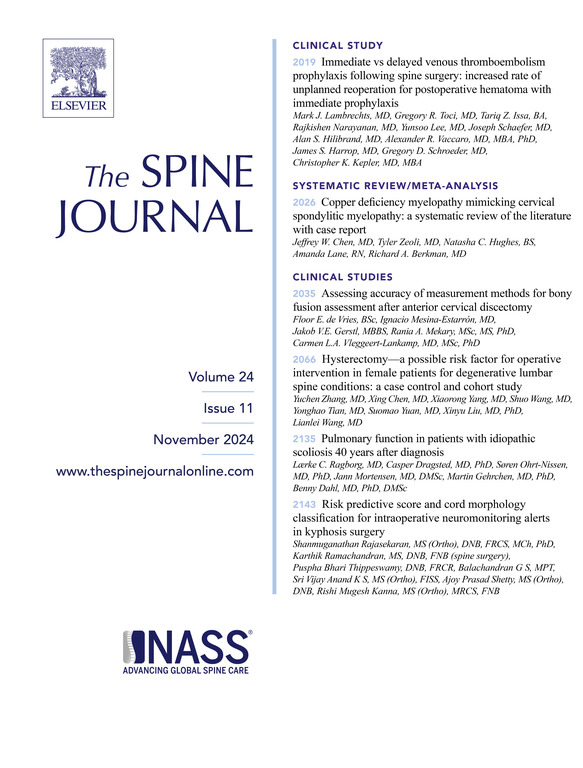Predicting quality of life of patients after treatment for spinal metastatic disease: development and internal evaluation
IF 4.9
1区 医学
Q1 CLINICAL NEUROLOGY
引用次数: 0
Abstract
Background Context
When treating spinal metastases in a palliative setting, maintaining or enhancing quality of life (QoL) is the primary therapeutic objective. Clinicians tailor their treatment strategy by weighing the QoL benefits against expected survival. To date, no available model exists that predicts QoL in patients after treatment for spinal metastases.
Purpose
To develop and internally evaluate a model predicting QoL for patients after treatment for spinal metastases, across the spectrum of (local) treatment modalities.
Study Design/Setting
Cohort study of prospectively collected data.
Patient Sample
Patients with spinal metastases referred to a single tertiary referral center in the Netherlands between January 1st, 2016, and December 31st, 2021.
Outcome Measures
The primary outcome was achieving a minimal clinically important difference (MCID) on QoL using the EQ-5D-3L index score 3 months after the referral visit (at the outpatient clinic or emergency department).
Methods
Five prediction models using machine learning were developed: random forest, stochastic gradient boosting, support vector machine, penalized logistic regression, and neural network. Performance was assessed using cross-validation during development and bootstrapping for internal evaluation with discrimination (area under the curve (AUC)), calibration, and decision curve analysis. This study was funded by the AOSpine under the Discovery & Innovation award (AOS-DIA-22-012-TUM). A total amount of CHF 40,000 ($45,000) was received.
Results
In total, 953 patients were included in the study, of which 308 (32%) achieved the MCID at 3 months. Discrimination was fair and comparable between the models, but the random forest model outperformed the other models on calibration and was therefore chosen as the final model (AUC 0.78; confidence interval (CI): 0.71 to 0.85; calibration intercept: -0.06; CI: -0.31 to 0.25; calibration slope: 1.05; CI: 0.70 to 1.44), with the following predictors ranked by importance: baseline EQ-5D-3L index score, Karnofsky Performance Scale, primary tumor histology, opioid use, and presence of brain metastases.
Conclusions
We developed and internally evaluated a random forest model that predicts clinically meaningful improvement of QoL 3 months after the baseline visit at the outpatient clinic for patients with spinal metastases. Future studies should externally evaluate the random forest model to confirm its robustness and generalizability in daily practice.
预测脊柱转移疾病治疗后患者的生活质量:发展和内部评估。
背景情况:在姑息治疗脊柱转移瘤时,维持或提高生活质量(QoL)是首要治疗目标。临床医生通过权衡 QoL 的益处和预期生存期来制定治疗策略。迄今为止,还没有可用的模型来预测脊柱转移瘤患者治疗后的生活质量。目的:开发并在内部评估一个模型,预测脊柱转移瘤患者治疗后的生活质量,包括各种(局部)治疗方式:患者样本:患者样本:2016年1月1日至2021年12月31日期间转诊至荷兰一家三级转诊中心的脊柱转移瘤患者:主要结果是在转诊后三个月(门诊或急诊科)使用EQ-5D-3L指数评分达到QoL的最小临床重要差异(MCID):方法: 利用机器学习开发了五种预测模型:随机森林、随机梯度提升、支持向量机、惩罚逻辑回归和神经网络。在开发过程中使用交叉验证评估性能,在内部评估时使用自举法进行判别(曲线下面积 (AUC))、校准和决策曲线分析。本研究由 AOSpine 的发现与创新奖(AOS-DIA-22-012-TUM)资助。共获得 40,000 瑞士法郎(45,000 美元):共有 953 名患者参与了研究,其中 308 人(32%)在三个月后达到了 MCID。各模型之间的区分度相当,但随机森林模型在校准方面优于其他模型,因此被选为最终模型(AUC 0.78;置信区间 (CI):0.71 至 0.85;校准截距:-0.06;CI:-0.31 至 0.25;校准斜率:1.05;CI:0.05):1.05;CI:0.70 至 1.44),以下预测因子按重要性排序:基线 EQ-5D-3L 指数评分、卡诺夫斯基表现量表、原发性肿瘤组织学、阿片类药物使用和脑转移的存在:我们开发并内部评估了一个随机森林模型,该模型可预测脊柱转移患者在门诊基线就诊三个月后有临床意义的 QoL 改善。未来的研究应该对随机森林模型进行外部评估,以确认其在日常实践中的稳健性和普适性。
本文章由计算机程序翻译,如有差异,请以英文原文为准。
求助全文
约1分钟内获得全文
求助全文
来源期刊

Spine Journal
医学-临床神经学
CiteScore
8.20
自引率
6.70%
发文量
680
审稿时长
13.1 weeks
期刊介绍:
The Spine Journal, the official journal of the North American Spine Society, is an international and multidisciplinary journal that publishes original, peer-reviewed articles on research and treatment related to the spine and spine care, including basic science and clinical investigations. It is a condition of publication that manuscripts submitted to The Spine Journal have not been published, and will not be simultaneously submitted or published elsewhere. The Spine Journal also publishes major reviews of specific topics by acknowledged authorities, technical notes, teaching editorials, and other special features, Letters to the Editor-in-Chief are encouraged.
 求助内容:
求助内容: 应助结果提醒方式:
应助结果提醒方式:


